Alderney and the Casquets Lighthouse
Getting There
Leaving from St.Catherine’s breakwater, it took us around 1 hour to reach the south side of Alderney. We were averaging around 30 knots and our passage took us between Les Dirouilles and Les Ecrehous.
Exploring the Alderney Coast
On arrival in Alderney we decided to explore Cachaliere Pier. This pier was originally an attempt to build a harbour on the south side of the island in the 30’s. Unfortunately they were unable to complete it due to rough seas and the challenging location. During the war it was partly blown up to prevent commando’s raiding the then German occupied island.
We left the pier heading west around the island passing Les Etacs rock, a well known Northern Gannet nesting site. The first sighting of these birds on Les Etacs was in 1940 with one pair nesting, now there are over 5765 nesting pairs. The nesting area around Alderney accounts for 2% of the global population of Northern Gannets.
Alderney by bike
We swiftly made our way through the Swinge and into Braye Harbour, pulling up a visitor mooring on arrival. Alderney harbours offer a water taxi service to and from your vessel which is very handy. Once on dry land we hired bikes and started our sightseeing tour of the island.
Our stops included:
- Longis Bay
- The Lighthouse
- Arch Bay
- Roselle Battery
- Cambridge Battery
One of the group decided to hire an electric bike, if you’re not the most athletic, this is a great option, especially for day trips where you won’t need to charge it. For lunch we stopped at Cantina Number 6 on Braye street. This area, on the west side of Braye beach, is where the majority of the island's eateries are located.
Casquets Lighthouse
Once finished we decided to jump back on the boat and head for the Casquets Lighthouse. On the journey we passed the island of Burhou, an uninhabited bird sanctuary banned from visitors between March 15th and July 27th. On arrival at the lighthouse we located the small jetty on the north side and skillfully managed to drop off the group. The speed of the tidal stream can reach around 6-7 knots, care has to be taken at all times, although the resident seals have no problems living in this environment.
The name Casquets is believed to derive from the French ‘cascade’, which alludes to the strong flow of tide around the rocks. There has been a lighthouse at the Casquets from 1724, where three towers were lit by coal. Conversion to electric was in 1954 and the lighthouse was automated in 1990.
After we had explored around the island we made our way back to Jersey, passing the Condor Liberation on her route to England.
Daniel Luce



